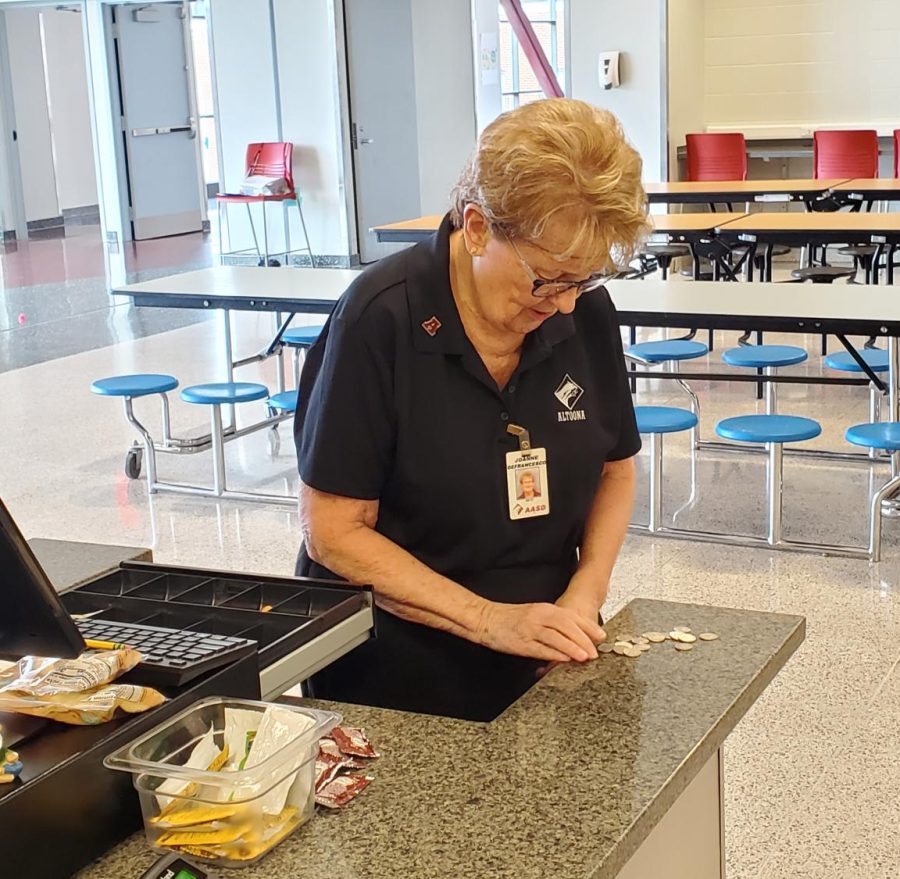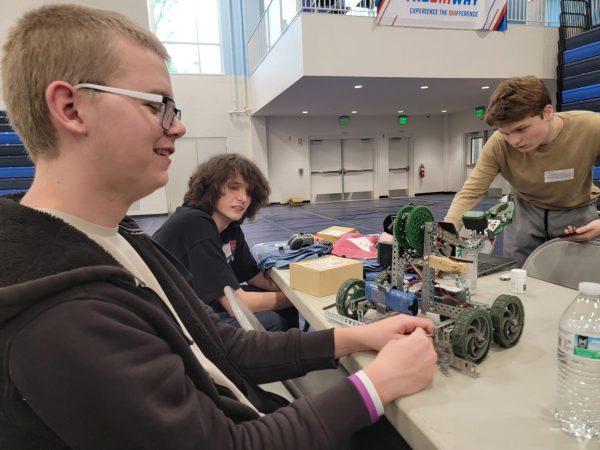Cafeteria workers serve thousands daily
Janna Defroncesco counts her money before putting it into her register. She is preparing for A lunch.
Tracey Stiffler starts her day as an assistant manager by arriving at school between 6:30 a.m. and 7:30 a.m. She was a lunch lady for 16 years and has been an assistant manager for six years. Everyday she comes into work, and if there are no issues with the equipment, deliveries or call-offs at the high school, she answers phone calls about issues with the equipment, deliveries or calls-offs from the elementary schools that she is in charge of. She ensures the schools have what they need for breakfast the next morning, and then she starts working on the lunch menus.
“There are two assistant managers. There’s me and Heather over at the junior high. I handle the high school and half of the elementary schools. She handles the other half and the junior high. I make the menus for the high school and elementary, but we are also being run by the federal state, and we have to follow their nutritional guidelines. It’s our job to make sure that all of the recipes we use and the items we serve fall within the official guidelines,” Stiffler said.
Stiffler suggests that students should give more positive feedback instead of constantly telling the cafeteria workers what they should have done differently, as well as wishing students know their job is not as easy as it seems.
“We have certain things we are allowed to serve. We have to watch the sodium content, the saturated fat and calories. We put together the main entrée and side dishes and have to watch how many calories are in the meal for the day and for the entire week, same with the sodium content. I just wish kids knew it’s not like we can just go buy what we want and serve it like we do at home. It’s time consuming to try to make a home cooked meal and feed 1,200 kids in 45 minutes. That’s the hardest part of our day,” Stiffler said.
There are a total of 23 workers in the kitchen. Staff come in every morning and start preparing breakfast for 300 students. Immediately after breakfast, they start preparing lunch.
“I really wish people knew, especially the kids, that these women care. I don’t think anybody realizes what goes into feeding that amount of kids twice a day, every day. If the kids had any recommendations for what they wanted for lunch, we could find a way to make it fit into the nutritional guidelines,” Stiffler said.
Daphne Gordon has been working in the cafeteria as a cook for 20 years. Her routine starts with arriving at school at 6:30 a.m. to prepare lunch. The first thing that is done is cleaning off designated stations and retrieving the needed supplies to prepare the menu item for that day. Her routine has been the same since she started her career.
“The other girls come in and do fruit and salad. When we get here, the breakfast people are already here,” Gordon said.
At 9:00 a.m. Janna Defroncesco comes into work and starts preparing the grills, finishing the hoagies, making the tuna sandwiches and putting the tuna on the salad. Everyone also takes care of the condiments. They make sure the napkins, spoons and forks are full along with refilling the condiments. There are three cashiers in the open cafeteria and five in the closed cafeteria. They place the cash in the drawer, lock it, then refill the milk, water and juice.
“They cut up the fresh fruit. They get the fruit stations ready. Since we have to have vegetables every day, they get the vegetable stations ready. There is a devoted person or persons that do breakfast every morning, so they prep for breakfast. We’re not just pretty faces,” Defroncesco said.
Every morning there is a meeting to go over the details about the day. Afterward, everyone does their individual jobs. Everyone assists with dishes when they are short staffed, along with other jobs.
“We’re responsible for emptying the trash into the big bin. Sometimes Fred’s available to empty it, sometimes he’s not. If he’s not, Melanie does it. She’s one of the cafeteria workers, which is very helpful because if we’re not paying attention they overflow the trash,” Defroncesco said.

Hi I'm Abigail, but you can call me Abby. This is my third year writing for the newspaper as well as my second year being on the Mountain Echo Newspaper...







